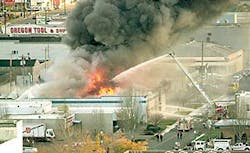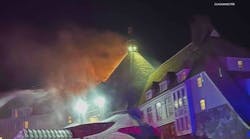Soot and water still covered Coos Bay Fire Chief Stan Gibson's yellow gear late Monday night when he stared, deadpan, away from the burned-out warehouse that killed three of his firefighters. It wasn't supposed to happen in Coos Bay, he said in a stunned voice.
"I never thought it would happen here," the weary chief said, after darkness set around downtown and artificial lights shined on the blackened building.
Less than 24 hours ago, firefighters with hats in hand and heads bowed formed a single line before the devastated blue structure that once housed Farwest Truck & Auto Supply. Draped in American flags, the bodies of two Coos Bay firefighters were ceremoniously carried out, honored by fellow firefighters and mourned by families, and placed into waiting ambulances. A third firefighter, also of Coos Bay, died after initially being rescued from the blaze earlier during the fight.
Robert "Chuck" Hanners, 33, a Coos Bay resident, died at Bay Area Hospital after being taken from the fire. A volunteer with eight years of experience, he never regained consciousness after being dragged from the blaze. Randall "Randy" Carpenter, 45, a Coos Bay resident and a career firefighter for 15 years, died inside the building. Jeffery "Jeff" E. Common, 30, a Coos Bay resident and volunteer for 12 years at Coos Bay and North Bend, also died inside the burning building.
"I worked with these people. I cared for these people," Gibson said, taking a personal moment that allowed for a glimpse beyond his duty and professionalism.
This morning, the sun rose above a soggy, charred warehouse, revealing the blackened cavity of the store carved out Monday by flames and cordoned off today by yellow police tape. One day after a soaring fire that burned and boomed with explosions, sending thick, bluish-black plumes into the air, the acrid stench of wet smoke still clung to Second Street.
"This is a dangerous job. We know somebody's going to die, but we just never thought it would happen," said an exhausted Lt. Randy Miles, sweat and tears mingling on his face.
It was early Monday afternoon when firefighters responded to a general alarm at 340 South Second St. and found what appeared to be an ordinary call -- light, yellow-brown smoke indicating an average fire but belied the ferocious fire to come.
Owner Kim Macfee said he and employees noticed a light smoke in the store shortly after 1 p.m. After checking the building's rooftop, Macfee said he thought nothing was wrong, but the smoke continued to grow.
By 1:45 p.m., Macfee said the smoke thickened and after calling the fire department and grabbing important data, he, about eight employees and several customers walked out of the store and waited for the fire department to arrive. All were uninjured.
"It started next to a stove in the back, up in the ceiling," Macfee said.
Officially, Coos Bay fire hasn't released information about how or where the fire began.
According to Gibson, the initial response inside the building included two teams of four firefighters, one on the first floor, a second in the attic. A third group walked atop a rooftop that became spongy and malleable from the searing heat.
The incident was dangerous but not out of the ordinary, Gibson said.
"The fire was a fire that we routinely handle," he said.
Unable to find the source of the fire and feeling the increasing temperature, firefighters on the inside became concerned that the blaze was burning in a dead zone between the roof and the top floor ceiling.
Gibson surmised that when firefighters tried to carve an opening in the building's ceiling, trapped gases that had heated found the oxygen they needed to flash into a blaze. The ceiling, floors and walls combusted immediately and possibly caused a rafter to dislodge and cave in on the men.
As the roof fell, Coos Bay firefighters in yellow gear and North Bend crews in black dived out of the building and sprawled along the curbside to count who had been left inside.
Men were missing.
"Get in there!" yelled a firefighter manning a hose at the building's entrance.
Other men pushed on, while explosions popped with balls of flames at each side of the door. Macfee, speeding continuously around the front of his burning building, yelled at firefighters trying to save remnants of his engulfed store.
"Get those men out of there," and "let it burn," Macfee said, knowing that explosive flammables cornered the auto supply store.
In what appeared to be organized chaos, men wielding foot-thick fire hoses sat in rows on the asphalt of Second Street, punching out windows that hadn't been blown out by the heat with pressurized water. Flames roared through the missing rooftop as caustic smoke from burning chemicals and auto supplies soared into the air.
Coos Bay fire engine No. 8151, gleaming red with its ladder fully extended, poured gallon after gallon of water atop the building, onto flames to be momentarily quenched and then burst once more. North Bend's ladder engine crew fought from the building's rear while other tenders and machinery cornered the boxy structure on every end. Eight agencies in all responded to the fire, some as support to back up those fighting the blaze and others to help directly.
Meanwhile, charred pieces of soaked building material that flew high into the air with the flames were carried by the wind and fell on hundreds of onlooking residents, many of whom had tears in their eyes.
When firefighters' fears heightened -- when they could feel the fire's heat but couldn't find the blaze and the rooftop began to melt -- everyone was ordered out, Gibson said. Teams were switching from an aggressive response attacking the blaze to a defensive position.
"There was an evacuation order," Gibson said. "Why the firefighters didn't evacuate will be determined by the investigation."
Miles, who was fighting the fire from the rear, said he heard two evacuation orders come out but no one ever heard any distress calls.
The investigation, conducted jointly by several agencies, including the Oregon State Police and state Fire Marshall, also will determine why the fire burned so hot, so out of control and so quickly.
Jon Eck, a 27-year veteran volunteer fireman said the department has had experience dealing with large fires like the one that destroyed Farwest.
"We've had bigger fires. We've had collapses," Eck said. "Each building is a little bit different. This one, I'm sure, because of the chemicals, was better fueled than some."
The fire is being considered accidental.
"I can say preliminarily that the fire at this time was not believed to be arson," Gibson said. "There is nothing suspicious about it."
Yet it began roaring in seconds.
Aerosol cans, paints, hydraulic fluid, paint thinners and motor oils were only some of the fuels that fed and accelerated the fire, making small explosions pop into bursts of flames and burning so hot that adjacent store employees said they could feel it 50 feet away.
It was after 2 p.m. when customers and employees at the nearby Salvation Army building were evacuated but most already had noticed and were monitoring the fire.
Steve Reed, warehouse supervisor, was atop the Salvation Army building when flames first seared about eight feet in the air from the burning auto store. Reed was putting out chunks of burning embers being blown from Farwest that landed atop the Salvation Army.
The massive blaze ended, sending ripple effects throughout the downtown community. An influx of telephone calls blocked many people's cell-phone communications. Street lights and signals were turned off when a main power line was cut to help firefighters in their attacks. Coos Bay Police officers on duty were stationed at each intersection near downtown to direct traffic. Police Chief Chuck Knight said off-duty officers were called in as reinforcements.
As the firefighting efforts died down with the building in total flames and smoke, some firefighters overcome by emotion collapsed on their knees in tears. Others, angered by the losses, shoved at equipment outside the building.
Meanwhile, many took refuge in the Bay Area Enterprises Thrift Store across the street from the burning building. In the end, all joined together as a unit and helped to cool the blaze and retrieve and identify the bodies of their comrades.
Smudged in soot and wet from fire fighting, Miles called the losses staggering.
"These three leave 11 children behind," Miles said. "For me, that's crushing."
For a city recently honored with a Silver Medal of Honor by the League of Oregon Cities for its safety and lack of injuries, the three deaths struck Coos Bay's fire department hard. It was a first painful blow for Coos Bay fire and an unprecedented one.
"No one can recall any other fatalities," Gibson said.
Full Coverage- Investigators: Hidden Fire Likely Burned for Hours
- Ore. Firefighters Leave Legacy of Bravery, Fellowship
- Firefighters from Around Oregon Come to Help
- Community in Shock Over Deaths of Three Firefighters
- Roof Collapse Takes Three Oregon Firefighters
- Victim Profiles and Funeral Information
- Goldfeder: Tragedies Like the Coos Bay Fire Cause Us to Think ... As They Should






